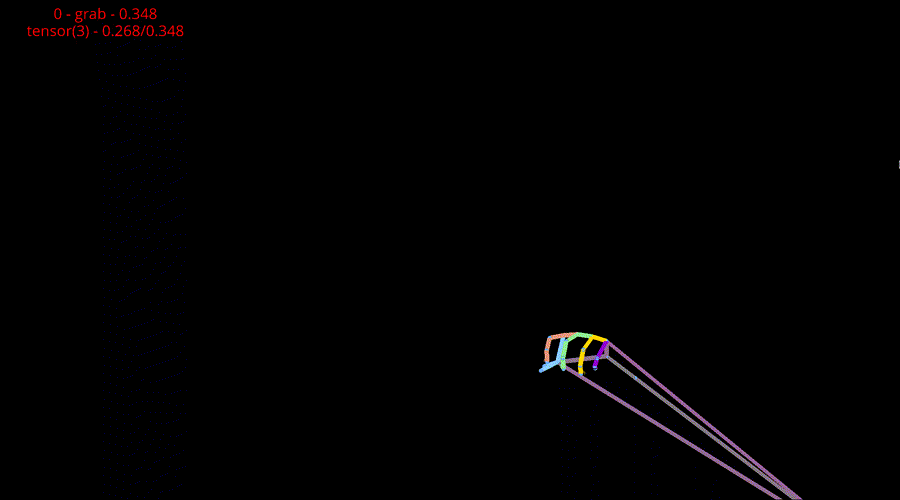3D dynamic hand gestures recognition using the Leap Motion sensor and
Convolutional Neural Networks
Andrea Ranieri - CNR-IMATI

History of computer vision in 4 slides #1

Credits: DSpace@MIT - Seymour A. Papert, The Summer Vision Project
History of computer vision in 4 slides #2
Credits: Kirill Danilyuk - CarND Project 1: Lane Lines Detection — A Complete Pipeline
History of computer vision in 4 slides #3
- Deep: 7 hidden “weight” layers
- Learned: all feature extractors initialized at white Gaussian noise and learned from the data
- Entirely supervised
-
More data = good
- Trained with stochastic gradient descent on two NVIDIA GPUs for about a week
- 650,000 neurons, 60,000,000 parameters, 630,000,000 connections
- Final feature layer: 4096-dimensional


Credits: Alex Krizhevsky - ImageNet Classification with Deep Convolutional Neural Networks
History of computer vision in 4 slides #4
- Very deep: up to 152 layers in the original paper
- Solves the the vanishing gradient problem through skip connections
- Batch normalization instead of dropout act as a regularizer
CNNs glossary #1
- 2D Convolutions
- Actually performed over the 3-channel volume
- Different kernels (learned) convolved with the input at different layers produce different outputs (feature maps)

Credits: Practical 3a: Convolutional Networks by Deep Learning Indaba
CNNs glossary #2
- Lower layer filters learn simple patterns (lines, curves, color gradients)
- Higher layer filters learn complex patterns (eyes, faces, textures, distinctive components of objects)
Credits: Visualizing and Understanding Convolutional Networks
CNNs glossary #3
- CNNs are trained in two phases:
- in the forward pass, features are extracted from the input image and the output of the network is compared to the ground truth through a loss function
- in the backward pass, neurons’ parameters (weights and biases) are adjusted through backpropagation (1989) and gradient descent
- Before ResNets, the vanishing gradient problem made deep CNNs difficult to train, because the so called “loss landscape” was too noisy for gradient descent to make progress

CNNs glossary #4
- At a higher level of abstraction, a CNN model is trained starting from:
- the network architecture (ResNet-34, ResNet-50, EfficientNet-B4, etc.)
- the dataset (typically composed of training/validation/test set) and a set of data augmentation transformations
- the loss function (crossentropy loss, MSE, MAE, etc.)
- the choice of hyperparameters (batch size, learning rate, number of training epochs, etc.)

3D Dynamic Hand Gestures Recognition
problem outline
- Dynamic Hand Gestures Recognition can be split into two subproblems:
- acquisition of the skeletons of the hands (hard)
- through hardware like gloves or Leap Motion
- through software with other NN models like Google MediaPipe
- (we’re using the Leap Motion sensor now because it’s convenient, but our approach is versatile)
- actual understanding of the dynamic gesture using “all its history” (also hard)
- training “traditional” tabular data classifiers (SVMs, feed-forward NN, LSTMs)
- training CNN classifiers to leverage 2D image structure -> powerful (learned) features extractors + transfer learning
- acquisition of the skeletons of the hands (hard)










3D Dynamic Hand Gestures Recognition
our approach
- Acquire hands skeleton data via the Leap Motion sensor (138 floats + label)
- Reinterpret the data to match the Leap Motion connection map to obtain both nodes and edges
- Draw the skeleton into a custom 3D visualizer made with VisPy (PyQt5 backend)
- Draw only the nodes representing the fingertips
- As the gesture progresses, keep the fingertips history and draw it with decreasing alpha values
- The history of the gesture fades away with time
- Add variable amounts of 3D noise as further data augmentation
- Capture the canvas of the 3D visualizer as the gesture progresses to create the dataset
- With different amounts of fingertips history and noise
- 4.6 Gb, ~77k images (starting from 468 training sequences)




3D Dynamic Hand Gestures Recognition
training the network and results
- The network has been trained in Python using Jupyter Notebook and the Fast.ai v1 library
- a little bit more high level than Pytorch
- great community that keeps it up to date with literature
- ResNet-50 pretrained on ImageNet and on our other 2k image hand gestures dataset
- Progressive resizing technique (192x108, 384x216, 576x324 and 960x540)
- Standard augmentation (rotate, crop+pad, flip, warp, zoom, brightness, contrast)
- Fit one cycle policy for training (i.e. cyclical learning rate)


3D Dynamic Hand Gestures Recognition
results #2
- Advantages of this approach:
- real-time (ResNet-50 theoretical throughput is 536 FPS on an Nvidia P40)
- scalable (with the dataset size)

Future research directions #1
- What’s the weak point of our current approach?
- There is no way to determine when a gesture starts or ends (it’s just a “single image” classifier)
- Once again, the developer has the burden of deciding when one gesture ends and another begins, when two predictions are part of the same gesture, etc.
- How do we do it?
- One prediction every two seconds (avg. duration of the gestures)
- Thresholds

Future research directions #2
- Two (or three?) possible ways to make the NN deal with temporal information:
- Currently working on:
- 3D-ResNet-50-KMS
- pretrained on Kinetics-700 (K), Moments in Time (M), STAIR-Actions (S)
- 3D-ResNet-50-KMS

Future research directions #3
- Same SHREC 2020 contest dataset
- This time not just single images, but entire sequences (30 frames)
- Plain sequences with basic data augmentation
- without partial sequences, without noise
- The good news is that the network is learning
Questions?




